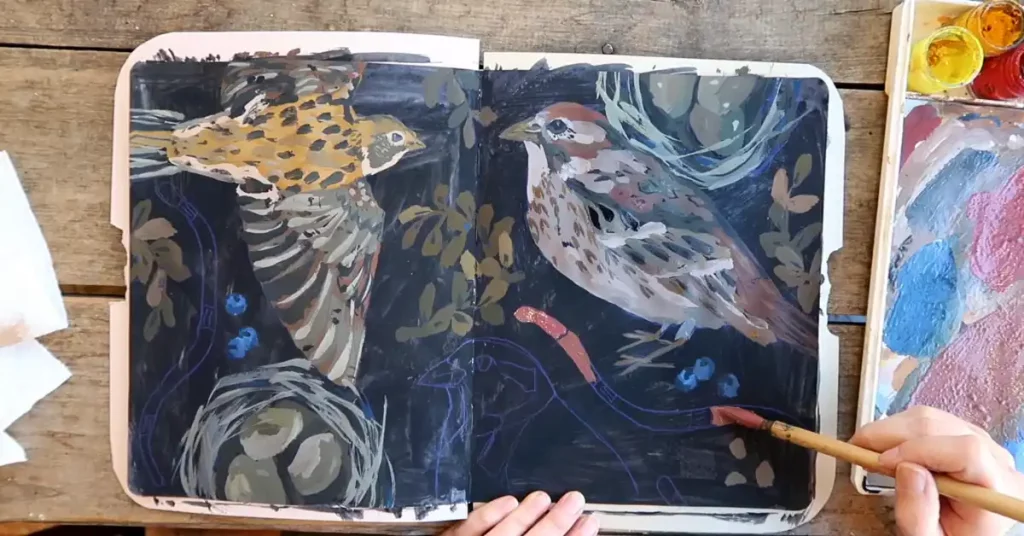Flashe Paint & Acrylics are two of the most popular paints among art enthusiasts. However, since Flashe paints act like Acrylics, many people get puzzled about their differences. Therefore, I will discuss, “Flashe Paint vs. Acrylic” in depth in this article. So, what are the vital differences between Flashe and Acrylics?

Flashe Paint & Acrylics are different in terms of binder, variety, reactivation, cost, and many more aspects. Flashe Paints use vinyl emulsion binder, whereas acrylic paint uses acrylic polymer emulsion. Due to the different binders, effects also slightly change. Moreover, Flashe Paints are vinyl paint that is less expensive than acrylics. Therefore, knowing these differences is vital to bring specific outcomes to your art.
Go through the entire article to discover more about the key characteristics and differences between Acrylic and Flashe paint. So, let’s start.
What is Flashe paint?
Lefranc Bourgeois, a well-known French art supply company, first invented Flashe paint as a substitute for traditional art supplies. Over time, the use of Flashe paint has diversified around different artistic disciplines, such as illustration, fine arts, etc. It enabled the artists to express their thoughts that were previously inexpressible through oil paints.
Flashe paints are vinyl paints, meaning the paints incorporate vinyl plastic or synthetic material that ensures the paint’s survival against damage. Vinyl paint dries highly matte, and it is super durable. Therefore, when you put them on a surface, it becomes a part of that surface. As a result, people usually use it on surfaces that have to endure severe stress apart from painting.

Regarding finish and texture, Flashe paints provide a sophisticated, creamy finish with no plasticky or cheap appearance. The fact that vinyl paints come in a variety of finishes, such as matte, glossy, luminous, satin, etc. Therefore, users will have many opportunities to experiment with vinyl paints with various finishes. Most of the time, Flashe paint gives a matte finish due to vinyl particles.
Flashe paint is water soluble but becomes water-resistant in dried condition. But don’t worry. Due to the high-quality pigments and preventive light reflection capabilities of Flashe, the color won’t change its shade once it has dried.
One of the significant advantages of Flashe paint is that it doesn’t crack or peel if you apply it thickly. The color will sit smoothly on the surface without any brushmark.
Vital features of Flashe paint:
- It is a vinyl paint
- It is water soluble but becomes waterproof when dry
- It provides a matte yet creamy texture with an excellent coverage
- Due to its superior pigment quality and density, it has excellent color retention capacity.
- Flashe paints won’t create a crack or peel.
- It is suitable for almost all surfaces, including oily and non-oily surfaces, such as glass, metal, wood, plastic, textile, leather, stone, etc.
What is Acrylic Paint?
Acrylic paint is a water-based color containing three major paint components: Pigment, binder, and solution. Acrylic pigments provide color, whereas acrylic polymer works as a binder and helps the pigments stick to a surface.

Acrylic Paint was invented in Germany during the 1930s that integrated the qualities of oil and watercolor paints. At that time, people used this paint for house painting. Since the 1950s, many artists have been using it as a substitute for oil paints. Currently, it has become one of the most popular paints due to its versatility and flexibility. Users can use it as oil paints or watercolors on different surfaces, such as paper, canvas, wood, plastic, fabric, glass, brick, cement, etc. You can also use acrylic paint as finger paint.
One of the fascinating facts about Acrylic paint is that it is available in various finishes. For instance, heavy-body acrylic paints provide the heaviest and thickest finish, whereas soft-body paints are smooth, fluid colors are creamy, and acrylic gouache is velvety matte. Therefore, creating different finishes and drawing patterns with acrylic paints is super easy.
Vital features of Acrylic paints:
- Acrylic paint is water soluble but becomes waterproof in dried condition.
- Artists can use it as oil paints and watercolors.
- It dries faster and is super easy to use.
- It has superior color retention ability.
- It is versatile and applicable to diverse surfaces
- It is the least toxic paints
Flashe Paint vs. Acrylic
From the above-mentioned sections, you have already gained an overall idea about Flashe and acrylic paints. Although they act pretty similar, there are some differences which I have listed below. If you want to know the differences between flashe vs gouache, you can check this article. So, let’s have a look:
| Criteria | Flashe Paint | Acrylic paint |
| Color type | Vinyl color | Water-based color |
| Reactivation | Users can not reactivate it with water | People can reactivate it with water |
| Color retention ability | It dries like its original color | Acrylic colors often get darker when dried |
| Binder | Vinyl emulsion binder | acrylic polymer |
| Crack | It doesn’t crack | Acrylic paints often crack in cold weather since it gets stiffer. |
Conclusion:
There are various types of paints with distinctive characteristics. While some act uniquely, some paints have similar features. Flashe and Acrylic paints have some shared features that make it difficult for beginners to differentiate them. Therefore, I have gone through “Flashe Paint vs. Acrylic” with their key features and differences. I hope this information will help the readers to choose the right one for them.

S. Pushon is a paint expert, self-taught artist, and currently working as an adviser in the paint industry as a Quality Improvement and Development Assistant.
An artist by heart, he draws remarkable art pieces and as a professional paint industry individual, he seeks the insight and shares with enthusiasts. Read more…
